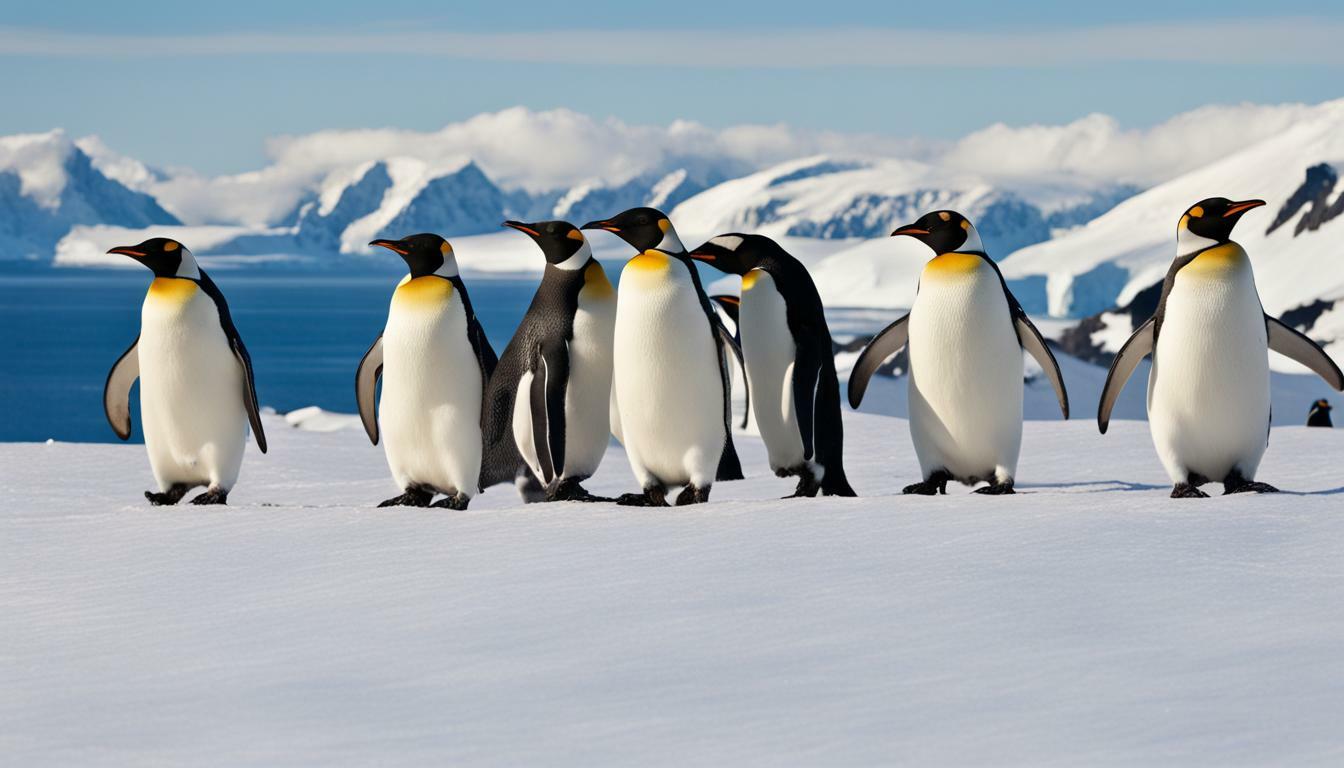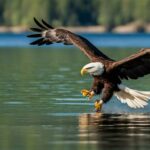If you’re wondering whether penguins can be found in Alaska, you’re not alone. These fascinating creatures have captured our imaginations with their unique appearance and impressive survival skills. In this guide, we will explore the question of whether penguins live in Alaska.
We will examine their habitat and distribution, and consider whether the natural conditions in Alaska could support penguin life. We will also delve into research and studies on penguins, focusing on their behavior and adaptations to cold climates.
Key Takeaways
- The question of whether penguins live in Alaska has long intrigued researchers and wildlife enthusiasts alike.
- Penguin habitats are diverse and vary depending on the species, but there is no evidence to suggest that any penguin species permanently reside in Alaska.
- While the natural conditions in Alaska may not be ideal for penguins, occasional sightings and vagrant individuals cannot be ruled out.
- Further research and observations are needed to fully understand the relationship between penguins and Alaska.
Penguin Habitats: Exploring the Possibility of Alaska
When it comes to penguins, there are 17 species that call our planet home. However, none of these species are native to Alaska. Despite this, there have been occasional sightings of penguins in Alaska, most likely vagrant individuals from other regions.
Some of the species of penguins found across the globe include:
| Penguin Species | Native Region |
|---|---|
| Emperor Penguin | Antarctica |
| King Penguin | Sub-Antarctic regions |
| Gentoo Penguin | Antarctica and sub-Antarctic islands |
| Adélie Penguin | Antarctica |
As you can see, all of the species listed above are typically found in the Southern Hemisphere, with the exception of the Galapagos Penguin, which is found near the equator. Unfortunately, none of these species have been known to breed or reside permanently in Alaska.
That being said, there have been reports of penguin sightings in Alaska in the past. Some of these sightings were likely vagrant individuals that moved outside of their typical range, while others may have been captive penguins that escaped from nearby zoos or aquariums. Nonetheless, these sightings cannot be confirmed as established populations in the state.
If you’re a penguin enthusiast and are hoping to catch a glimpse of these fascinating creatures, you may want to consider traveling to regions where penguins do occur naturally, such as Antarctica, South Africa, or the Galapagos Islands.
In conclusion, while there is no documented evidence of penguins residing permanently in Alaska, there have been occasional sightings of these birds in the state. However, if you’re looking to see these flightless birds up close, you may want to plan a trip to regions where penguins are known to exist.
Penguins’ Preferred Environments: What Alaska Offers
Now that we have explored the question of whether penguins can be found in Alaska, let’s examine the preferred environments of these fascinating creatures. Penguins are typically found in the Southern Hemisphere, where they inhabit icy and rocky regions such as Antarctica, the sub-Antarctic islands, and parts of South America, Africa, and Australia.
While Alaska may not seem like a natural habitat for penguins, it does share some similarities with their preferred environments. Penguins require cold temperatures and access to food-rich waters, which Alaska’s oceans and coastal regions can provide. However, unlike their Southern Hemisphere habitats, Alaska’s environment is not entirely ice-covered, which may deter some penguin species from making it their home.
Moreover, penguins typically require easy access to dry land in order to breed, something that is not always available in Alaska’s rugged and icy terrain. Additionally, penguins require a stable food source, which may be challenging in Alaska’s changing ecosystem.
The Alaska Connection: Studying Penguin Behavior
Scientists have extensively studied penguins across the globe, gathering data on their behavior, migration patterns, and preferred habitats. Some studies have examined whether penguins can be found in Alaska, or if they have ever been spotted in the state.
While there is no concrete evidence to suggest penguins live in Alaska, some research has included observations of penguins in nearby Canadian regions. For example, the Northern rockhopper penguin has been recorded in Haida Gwaii, a remote archipelago off the coast of British Columbia. However, these sightings are rare and cannot be used to definitively prove the presence of penguins in Alaska.
In addition, some scientists have looked at the effects of climate change on penguin populations. As temperatures rise and ice melts, penguins may need to adapt their behaviors to survive. Some studies suggest that as Arctic regions become more hospitable due to climate change, penguins may eventually move northward. Alaska, with its vast stretches of icy coastlines, could theoretically become an attractive habitat for penguins in the future.
Several studies have also examined the behavior of penguins in captivity. While not directly related to the question of penguins in Alaska, this research helps scientists understand the species as a whole and how they may behave in different environments.
Overall, while there is no concrete evidence to suggest that penguins permanently live in Alaska, research on penguin behavior and migration offers tantalizing hints that these fascinating birds may one day make their home in the icy state.
Unique Arctic Penguins: Adapting to a Cold Climate
It’s no secret that penguins are well-equipped to handle the cold temperatures of their natural habitats. However, could they survive in the frigid environment of Alaska? Let’s take a closer look at their unique adaptations that allow them to thrive in Arctic regions.
First and foremost, penguins have a thick layer of blubber that helps insulate their bodies against the cold. This layer of fat is crucial for their survival, as it enables them to maintain a healthy body temperature in freezing water and air temperatures.
Another adaptation that allows penguins to survive in the cold is their unique feathers. Penguin feathers are specially designed to trap air close to the skin, which creates a layer of insulation to keep them warm. Additionally, their feathers are tightly packed and waterproof, which helps them stay dry and maintain their body temperature, even when they are submerged in icy water.
Penguins are also excellent swimmers, thanks to their streamlined bodies and powerful flippers. They are able to navigate through the icy waters of the Arctic and search for food sources, such as fish and krill. In fact, some penguin species have adapted to live exclusively in cold water environments, making them even better suited for the harsh conditions of Alaska.
While none of the 18 species of penguins are native to Alaska, it’s not impossible for vagrant individuals to find their way to the state. In fact, there have been a few documented sightings of penguins in Alaska over the years, likely due to their accidental transport on boats and ships. However, these occurrences are rare and not enough to suggest a permanent population of penguins in the state.
Overall, while penguins are certainly well-equipped to handle cold temperatures, it seems unlikely that they would call Alaska their permanent home. Their adaptations and behaviors have helped them thrive in their natural habitats, and occasional sightings in Alaska are likely just isolated incidents.
The Reality: Penguins and Alaska
After exploring the habitats, behaviors, and adaptations of penguins, we can now present a balanced perspective on the question “Are There Penguins In Alaska?” Unfortunately, there is no conclusive evidence to support the presence of penguins in Alaska. While some studies suggest the possibility of penguins in Alaska, there have been no confirmed sightings or documentation of penguins residing in the state.
However, it is possible that vagrant individuals may occasionally visit Alaska, as they have been observed in other areas outside of their typical distribution range. These individuals could have been displaced by ocean currents or storms and ended up in Alaska by chance.
It is also important to note that while Alaska may not be home to penguins, it is still a vital environment for a diverse range of Arctic and sub-Arctic wildlife. Polar bears, walruses, seals, whales, and numerous bird species can be found in the state, making it a unique and important area for wildlife conservation and research.
Further research and observations are needed to fully understand the relationship between penguins and Alaska. Until then, we can appreciate the fascinating adaptations of these flightless birds and the diverse ecosystems they inhabit around the world.
Are Penguins Native to Antarctica Only, or Can They Be Found in Other Locations?
Are there penguins in antarctica only, or can they be found in other locations? Penguins are primarily associated with Antarctica, where they thrive in the harsh conditions. However, these flightless birds can also be found in other locations such as the southern coastlines of South America, the Falkland Islands, and some sub-Antarctic islands.
Conclusion: The Truth about Penguins in Alaska
After exploring the various aspects of the question “Are There Penguins In Alaska?”, it is safe to say that there is no concrete evidence to support the permanent presence of penguins in Alaska. While occasional sightings and vagrant individuals cannot be ruled out, penguins do not typically reside in this state.
While some studies suggest the possibility of penguins in Alaska, the natural conditions in Alaska may not be suitable for penguins to thrive and survive. Additionally, research and observations indicate that penguins tend to reside in the southern hemisphere, specifically in Antarctica, South Africa, and South America.
In conclusion, penguins cannot be considered a native species in Alaska. However, scientists and researchers continue to study and learn more about these fascinating creatures, and it is always possible that new discoveries may emerge in the future. If you ever find yourself in Alaska, keep an eye out for the occasional penguin sighting. You never know what nature has in store for you!











